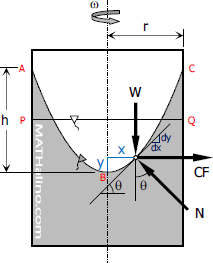Rotation - Rotating Vessel
When at rest, the surface of mass of liquid is horizontal at PQ as shown in the figure. When this mass of liquid is rotated about a vertical axis at constant angular velocity ω radian per second, it will assume the surface ABC which is parabolic. Every particle is subjected to centripetal force or centrifugal force CF = mω2x which produces centripetal acceleration towards the center of rotation. Other forces that acts are gravity force W = mg and normal force N.


$\tan \theta = \dfrac{CF}{W}$
$\tan \theta = \dfrac{m\omega^2x}{mg}$
Where tan θ is the slope at the surface of paraboloid at any distance x from the axis of rotation.
From Calculus, y’ = slope, thus
$\dfrac{dy}{dx} = \tan \theta$
$\dfrac{dy}{dx} = \dfrac{\omega^2x}{g}$
$dy = \dfrac{\omega^2}{g}x ~ dx$
$\displaystyle \int dy = \dfrac{\omega^2}{g} \int x ~ dx$
For cylindrical vessel of radius r revolved about its vertical axis, the height h of paraboloid is
Other Formulas
By squared-property of parabola, the relationship of y, x, h and r is defined by
Volume of paraboloid of revolution
Important conversion factor
- Log in to post comments
